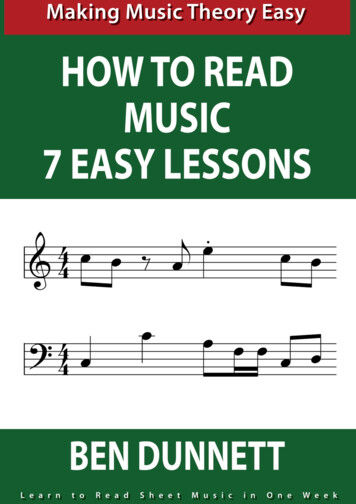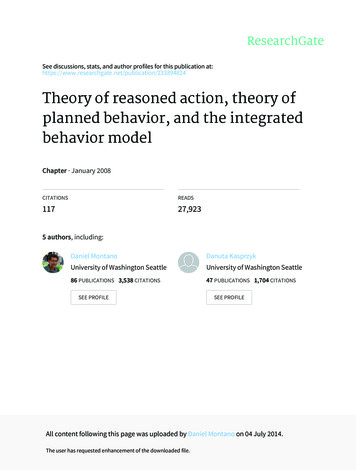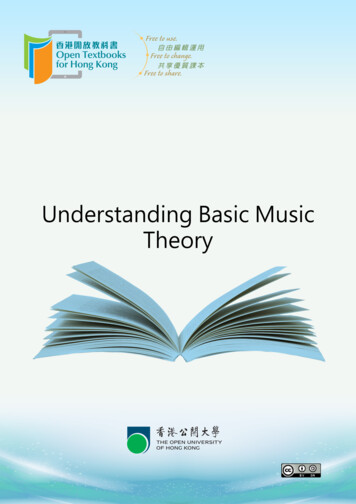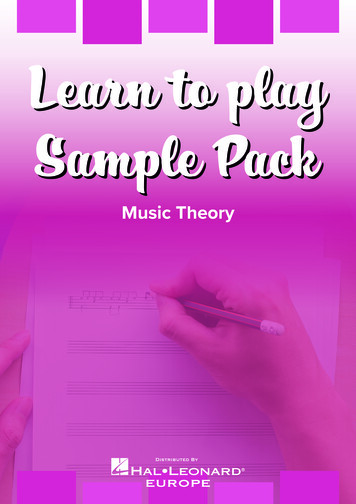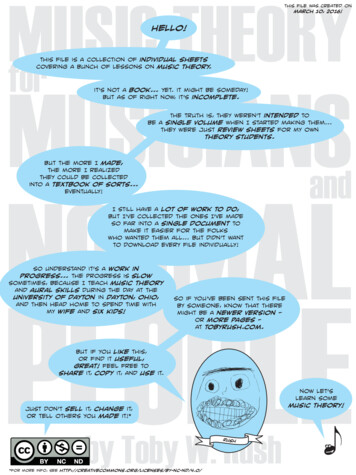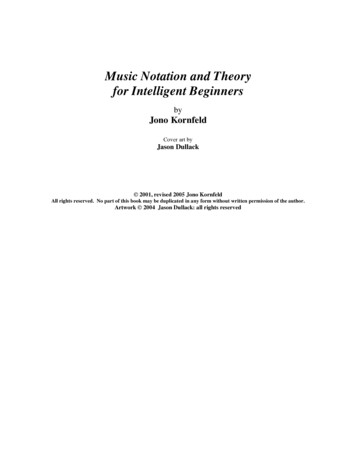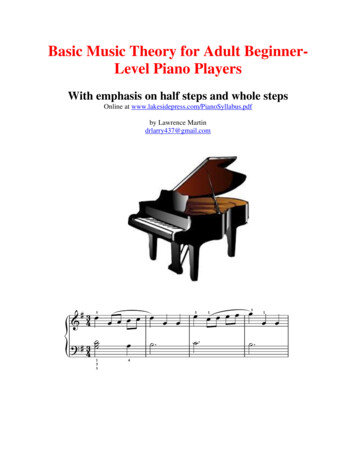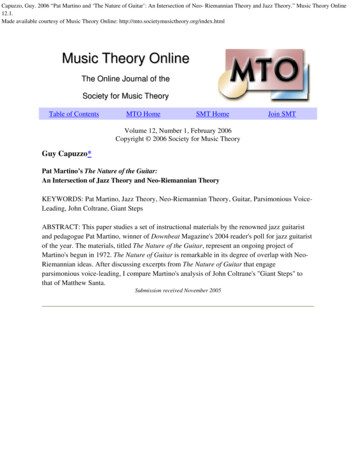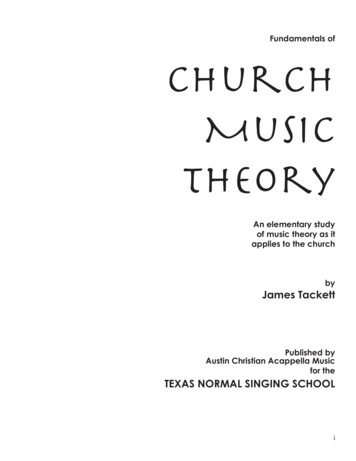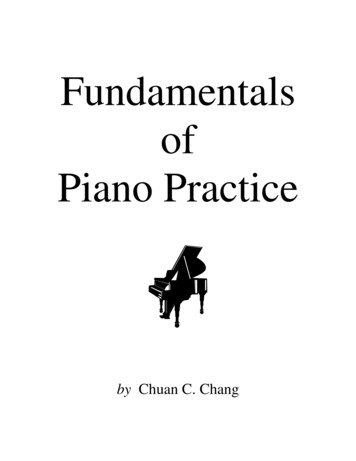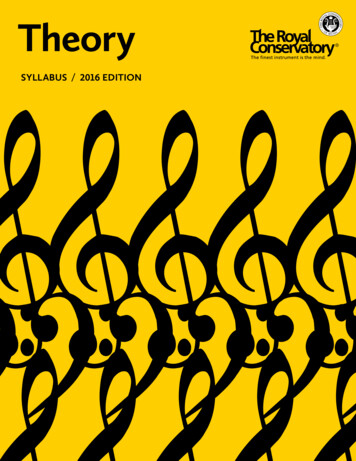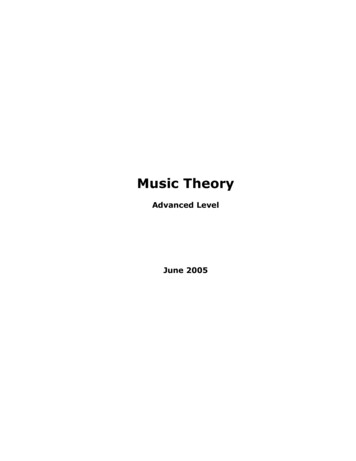
Transcription
Music TheoryAdvanced LevelJune 2005
Defining modes . 4Theory. 4Most Important Modes . 5Summary . 7Using Modes for Improvisation . 9Theory. 10A. Recap . 10B Choosing appropriate modes . 11Using Modes for Composition. 16Usage . 18The Dorian Mode. 19The Phrygian Mode . 22The Lydian and Mixolydian Modes . 24Lydian Mode . 24Mixolydian mode . 25The Locrian Mode. 27Usage . 27Modulation. 29Modulating into the parent key . 29Modulating into an adjacent key. 30Modulating into remote keys . 31Inter-tonal Exchanges. 322
IntroductionThis document is part of a compilation of a series of threads that deal with music theory and thatwere originally published by Eowyn on www.mysongbook.com. The compilation has beenreorganized into three separate documents: Basic Music Theory Intermediate Music Theory Advanced Music Theory – this documentThis has been done for two reasons:1. The size of one single file was too large for download2. The material covered by the different topics is of varying levels of complexity andtargets different audiences.The text of the original threads has been modified and/or extended in several places where it wasdeemed appropriate for increased readability. The rather crude layout of the original text (due tothe limitation of the forum) has also been improved. Finally, the text has been proof-read byArnold and Blackiel.This is by no means an exhaustive treatise about music theory and harmony. Much moremodestly, the purpose of this series of topics is to give those willing to better understand what theyare doing with their guitar, the ability to get this knowledge into a quick and concise form. Theunderlying objective is lead work and improvisation in a rock music context (broadly speaking), butmost topics are of a more general nature and they can also easily be adapted to other musicalgenres.There are numerous books and web sites about general music theory and more specialised topics.Interested readers will find a short reference list at the end of the Basic Level document.Copyright NoticeThe information contained in this document and this document itself can be freely downloaded,used and copied for private educational purposes only. Selling of this document is strictlyprohibited in all circumstances.3
Defining modesModes. A very controversial topic that seems to confuse the hell out of many people. Opinionsvary from "Modes are completely useless - the major and minor scales are all you need" all theway to "The next best thing since sliced bread!"In fact, many people fail to make the distinction between a number of fundamentally differentconcepts such as "modes", “scales”, "modal music versus tonal music" and others. I'll try my bestto be as concise and accurate as possible, and yet remain simple!In this topic, we will simply define modes (even that is often controversial!), leaving their practicalusage for later topics.TheoryWe define a mode as follows: a musical mode is an ordered series of intervals with respect to astarting note (whose absolute pitch is not specified).In other words, a mode simply defines a series of relative pitches; for example:12b3456b78What this example mode definition says, is the following: given the (unspecified) starting note (1),the second note is a major second away from it (2), the third note is a minor third away from it(b3), the fourth note is a perfect fourth away from it (4), etc.An equivalent way of defining a mode consists in enumerating the sequence of intervals betweenthe various relative pitches (as opposed to their definition with respect to a starting note); for theexample mode above that would be:WHWWWHWThe example above happens to be a seven note mode, and it just so happens that Western musicdeals primarily with those, but of course you can define an infinite number of modes using anarbitrary number of constituent notes. Many traditional Indian and Chinese modes use 5 notes, forexample.A mode is different from a scale! The mode is completely abstract, since it does not impose astarting pitch. If you specify the starting note by its absolute pitch, and apply the definition of themode, you obtain a scale. The scale can be thought of as the melody of the mode once youindicate the starting note.For example, starting with the note C, the mode above becomes:CDEbFGABb(C)4
If you start with A, you get:ABCDEF#G(A)The mode is the same, but the scales are clearly different.Modes have been dominant in Western music until the late Middle-Ages. Pope Gregorius is knownfor his complete and sophisticated theorisation of the musical systems to be used by the church,and still known today as Gregorian Chant or Plain Chant. In that system, the definition of thevarious modes consisted as much in the specification of the relative pitches (as we did) as in therigorous definition of the melodic organization and prescribed cadences (that we don’t need toworry about for now). The Gregorian modal system is heavily based on the Pythagorean system,and the names of the various modes come from the ancient Greek names (although Gregorius hadthem all mixed up!). We still use these names today (see below), but our names are againdifferent from what they used to be in the Middle-Ages.Most Important ModesIn order to be able to theorize about modes, it is convenient to be able to name them. Below is alist of the most important modes and their definitions.Remember: in these definitions, the symbols represent intervals with respect to the starting note,which is always notated “1”.Group 56b71b2345b6b7Group orianAlteredPhrygian5
bb7123#456B7LydianAlteredMyxolyianGroup IIIBartokThese tables may seem like an overwhelming amount to memorise. In fact, it is rather easy.The modes of Group I are the so-called “modes of the major scale”. By now you should realise thatthere is no such thing as the mode of a scale, but we nevertheless use this expression as aconvenient shortcut to remember the definitions of the modes. The Ionian mode is nothing elsebut the major scale.You obtain the Dorian mode by “starting a major scale from its second degree”. For example:DEFGABCDis D Dorian and is a C major scale started from D (second degree of the C major scale)Similarly, the scale:ABCDEF#GAis A Dorian, and is a G major scale “started from the A”.The double quotes are there to show that this is just short hand convention. We will omit themfrom now on.The modes of Group I are obtained as follows: The Ionian mode is the same as the major scale itself The Dorian mode is a major scale started from the second degree The Phrygian mode is a major scale started from the third degree The Lydian mode is a major scale started from the fourth degree The Mixolydian mode is a major scale started from the fifth degree The Aeolian mode is a major scale started from the sixth degree Finally, the Locrian mode is a major scale started from the seventh degreeLooking at the modes defined in Group I, you will notice that three of them are major (Ionian,Lydian, Mixolydian) since their third is major, and four of them are minor (Dorian, Phrygian,Aeolian, Locrian) since their third is minor.6
The modes of Group II can all be related to the harmonic minor mode, in a way similar to what wedid for the modes of Group I. The first mode of Group II is the harmonic minor mode; the AlteredLocrian mode is derived from the harmonic minor mode by starting from the second degree. TheAltered Ionian mode is a harmonic minor mode started from the third degree, etc.The modes of Group II are obtained as follows: The Altered Locrian mode is a harmonic minor scale started from the second degree The Altered Ionian mode is a harmonic minor scale started from the third degree The Altered Dorian mode is a harmonic minor scale started from the fourth degree The Altered Phrygian mode (also known as Major Dominant Phrygian) is a harmonic minorscale started from the fifth degree The Altered Lydian mode is a harmonic minor scale started from the sixth degree The Altered Mixolydian mode is a harmonic minor scale started from the seventh degreeFinally, Group III contains the modes derived from the melodic minor scale; however, there is onlyone mode that is really worth mentioning: the Bartok mode, which is the fourth mode of themelodic minor scale. This mode is named after the Hungarian composer Belà Bartok, and is one ofthe most popular modes in the East-European music.SummaryModes have been used in music long before the Western world started to favour harmony, andsettled for the major and minor scales. Most other popular musical systems in the world are stillmostly modal.Modes can be defined at will, and don’t have to be based on seven notes; this just happens to bethe most useful set in Western music.Although the modes are in fact defined completely independently from each other, it is convenientto related them to the major and minor scales:The Ionian mode is the first mode of the major scale.The Dorian mode is the second mode of the major scale.The Phrygian mode is the third mode of the major scale.The Lydian mode is the fourth mode of the major scale.The Mixolydian mode is the fifth mode of the major scale.The Aeolian mode is the sixth mode of the major scale (and equal to the natural minor mode).The Locrian mode is the seventh mode of the major scale.The Altered Locrian mode is the second mode of the harmonic minor scale.The Altered Ionian mode is the third mode of the harmonic minor scale.The Altered Dorian mode is the fourth mode of the harmonic minor scale.The Altered Phrygian mode is the fifth mode of the harmonic minor scale.The Altered Lydian mode is the sixth mode of the harmonic minor scale.The Altered Mixolydian mode is the seventh mode of the harmonic minor scale.7
The Bartok mode is the fourth mode of the melodic minor scale.8
Using Modes for ImprovisationIn the previous section, we defined all sorts of modes; we will now discuss how they can be used inpractice: improvisation (in this topic) and composition (in future topics).Using modes for improvisation requires that you clearly understand the relationship betweenmodes, scales and tonality.One of the dominant features of modal (church) music in the Middle-Ages is the fact that it waspurely monodic (a single melody line sung at unison). In the late Middle-Ages, with the birth ofcounterpoint (several melodic lines sung simultaneously but independently), and at theRenaissance when music became downright polyphonic (several melodic lines simultaneously atrest to form chords), the modes were gradually abandoned and replaced by the tonal system.However, two modes were kept: the Ionian mode (major) and the Aeolian mode (minor). TheAeolian mode itself further evolved (for tonal reasons) to give birth to the harmonic minor scaleand later the melodic minor scale.In contrast, most traditional musical systems in the world have kept the modal characteristics, andare still modal, even today. This is notably the case of the East-European music, African music,Indian music, Chinese music, and so forth.As said, the original modal music was monodic: e
Modes have been used in music long before the Western world started to favour harmony, and settled for the major and minor scales. Most other popular musical systems in the world are still mostly modal. Modes can be defined at will, and don’t have to be based on seven notes; this just happens to be the most useful set in Western music. Although the modes are in fact defined completely .
